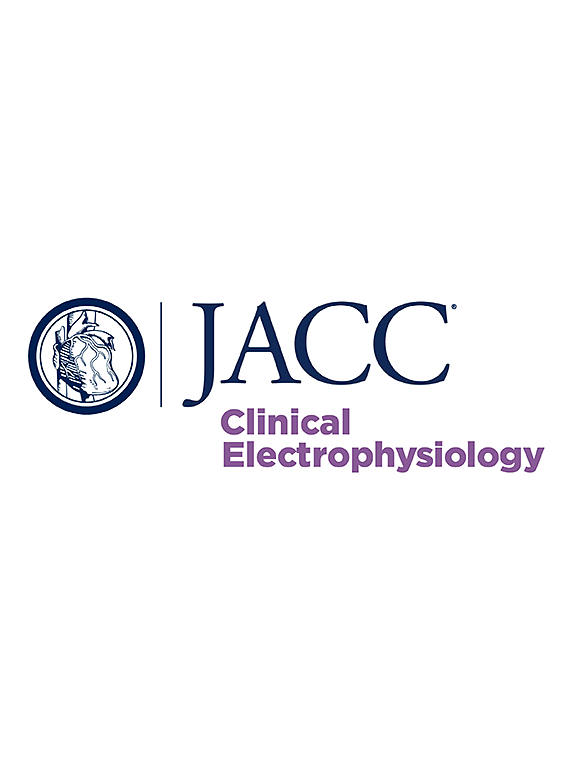识别左束分支俘获的新心电图形态学标准。
IF 7.7
1区 医学
Q1 CARDIAC & CARDIOVASCULAR SYSTEMS
引用次数: 0
摘要
背景:左束分支起搏过程中左束分支捕获(LBBc)的识别仍然具有挑战性。目的:本研究旨在验证用于鉴别LBBc的新的简单形态学标准的实用性。方法:纳入在递减输出量起搏过程中存在QRS转换而证实为LBBc的患者。定量和定性评价有节奏的V6 QRS上/下冲程,并将其分为快速或缓慢,快速上冲程模式与LBBc相关,缓慢上冲程模式与左室间隔捕获(LVSc)相关。此外,在导联插入期间未出现的导联中出现有节奏的QRS下冲程模糊/缺口和/或在较低导联中出现“M”型QRS模式也被认为是LBBc的提示。这些标准的准确性由独立评估人员使用定性心电图形态学特征进行测试。结果:纳入115例确诊的LBBc患者。LBBc组V6 QRS平均上冲持续时间显著短于LVSc组(34.6±10.1 ms vs 63.2±12.1 ms);P < 0.001)。结论:简单的心电图形态学标准可以准确识别基线QRS狭窄和/或无心肌病患者左束支区起搏时的LBBc。本文章由计算机程序翻译,如有差异,请以英文原文为准。
New ECG Morphologic Criteria for the Identification of Left Bundle Branch Capture
Background
Identification of left bundle branch capture (LBBc) during left bundle branch area pacing remains challenging.
Objectives
This study sought to validate the utility of new simple morphologic criteria for the identification of LBBc.
Methods
Patients with proven LBBc based on the presence of QRS transition during decremental output pacing were included. The paced V6 QRS upstroke/downstroke was quantitatively and qualitatively evaluated, and classified as fast or slow, with fast upstroke patterns associated with LBBc and slow upstroke patterns with left ventricular septal capture (LVSc). Additionally, the appearance of a paced QRS downstroke slurring/notching in any lead not previously present during lead penetration and/or an “M” QRS pattern in inferior leads was also considered suggestive of LBBc. Accuracy of these criteria was tested by independent evaluators using exclusively qualitative electrocardiogram morphologic features.
Results
115 patients with proven LBBc were included. Mean V6 QRS upstroke duration during LBBc was significantly shorter than during LVSc (34.6 ± 10.1 ms vs 63.2 ± 12.1 ms; P < 0.001). A paced V6 upstroke/downstroke ratio <1 had a sensitivity and specificity of 0.97 and 0.95 for the identification of LBBc. A slurred/notched QRS downstroke or “M” pattern in inferior leads was present in 91.1% during LBBc in baseline narrow QRS patients with inferior paced QRS axis, with sensitivity and specificity being 0.91 and 0.87, respectively. Using exclusively qualitative criteria, independent evaluators were able to identify the correct capture pattern in 87% of LBBc and 89% of LVSc cases, with diagnostic accuracy being significantly lower among dilated cardiomyopathy patients: 70.4% vs 93%; P = 0.004.
Conclusions
Simple electrocardiogram morphologic criteria can accurately identify LBBc during left bundle branch area pacing in patients with baseline narrow QRS and/or without cardiomyopathy.
求助全文
通过发布文献求助,成功后即可免费获取论文全文。
去求助
来源期刊

JACC. Clinical electrophysiology
CARDIAC & CARDIOVASCULAR SYSTEMS-
CiteScore
10.30
自引率
5.70%
发文量
250
期刊介绍:
JACC: Clinical Electrophysiology is one of a family of specialist journals launched by the renowned Journal of the American College of Cardiology (JACC). It encompasses all aspects of the epidemiology, pathogenesis, diagnosis and treatment of cardiac arrhythmias. Submissions of original research and state-of-the-art reviews from cardiology, cardiovascular surgery, neurology, outcomes research, and related fields are encouraged. Experimental and preclinical work that directly relates to diagnostic or therapeutic interventions are also encouraged. In general, case reports will not be considered for publication.
 求助内容:
求助内容: 应助结果提醒方式:
应助结果提醒方式:


